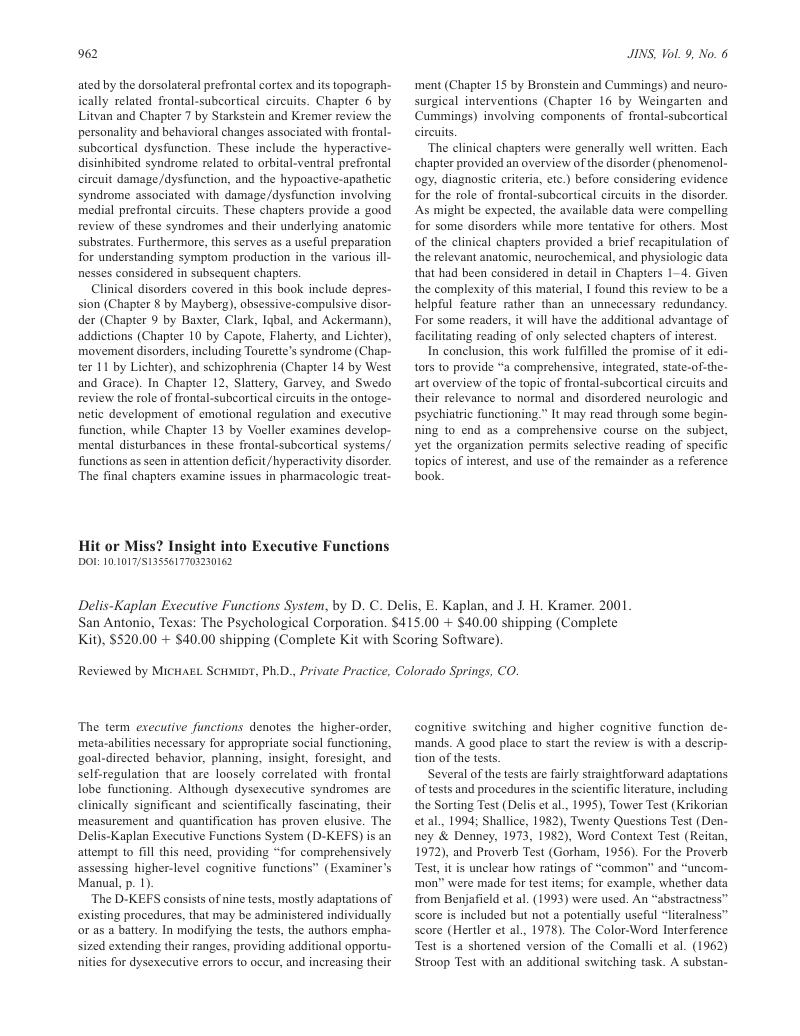Crossref Citations
This article has been cited by the following publications. This list is generated based on data provided by Crossref.
DELIS, DEAN C.
KRAMER, JOEL H.
KAPLAN, EDITH
and
HOLDNACK, JAMES
2004.
Reliability and validity of the Delis-Kaplan Executive Function System: An update.
Journal of the International Neuropsychological Society,
Vol. 10,
Issue. 2,
p.
301.
Shunk, Adam W.
Davis, Andrew S.
and
Dean, Raymond S.
2006.
TEST REVIEW: Dean C. Delis, Edith Kaplan & Joel H. Kramer, Delis Kaplan Executive Function System (D-KEFS), The Psychological Corporation, San Antonio, TX, 2001. $415.00 (complete kit).
Applied Neuropsychology,
Vol. 13,
Issue. 4,
p.
275.
CRAWFORD, JOHN R.
SUTHERLAND, DAVID
and
GARTHWAITE, PAUL H.
2008.
On the reliability and standard errors of measurement of contrast measures from the D-KEFS.
Journal of the International Neuropsychological Society,
Vol. 14,
Issue. 6,
p.
1069.
Schmid, M.
Strand, M.
Ardal, G.
Lund, A.
and
Hammar, A.
2011.
Prolonged Impairment in Inhibition and Semantic Fluency in a Follow-up Study of Recurrent Major Depression.
Archives of Clinical Neuropsychology,
Vol. 26,
Issue. 7,
p.
677.
Wackym, P. Ashley
Balaban, Carey D.
Mackay, Heather T.
Wood, Scott J.
Lundell, Christopher J.
Carter, Dale M.
and
Siker, David A.
2016.
Longitudinal Cognitive and Neurobehavioral Functional Outcomes Before and After Repairing Otic Capsule Dehiscence.
Otology & Neurotology,
Vol. 37,
Issue. 1,
p.
70.
Lemann, Elizabeth Roberds
Davis, Andrew S.
Finch, W. Holmes
and
Pierson, Eric E.
2019.
Evaluating the relation between CHC cognitive factors and selected components of executive functioning..
Journal of Pediatric Neuropsychology,
Vol. 5,
Issue. 4,
p.
152.
Simon, Kathryn A.
2020.
Encyclopedia of Autism Spectrum Disorders.
p.
1.
Simon, Kathryn A.
2021.
Encyclopedia of Autism Spectrum Disorders.
p.
2555.
Kolovelonis, Athanasios
and
Goudas, Marios
2023.
Acute enhancement of executive functions through cognitively challenging physical activity games in elementary physical education.
European Physical Education Review,
Vol. 29,
Issue. 2,
p.
268.
Furley, Philip
Schütz, Lisa-Marie
and
Wood, Greg
2023.
A critical review of research on executive functions in sport and exercise.
International Review of Sport and Exercise Psychology,
p.
1.
Rosinger, Asher Y.
John, Jason D.
and
Murdock, Kyle W.
2024.
Ad libitum dehydration is associated with poorer performance on a sustained attention task but not other measures of cognitive performance among middle‐to‐older aged community‐dwelling adults: A short‐term longitudinal study.
American Journal of Human Biology,
Vol. 36,
Issue. 6,
Hacker, David
Jones, Christopher A.
Chan, Yin Ming
Yasin, Eyrsa
Clowes, Zoe
Belli, Antonio
Cooper, Julian
Bose, Deepa
Hawkins, Andrew
Davies, Holly
and
Paton, Emily
2024.
Examining the validity of the Delis–Kaplan Executive Function System (D‐KEFS) in traumatic brain injury.
Journal of Neuropsychology,
Vol. 18,
Issue. 1,
p.
81.
Furey, Rachel T.
Bowden, Stephen C.
Jewsbury, Paul A.
Sudarshan, Navaneetham J.
and
Connolly, Madeleine L.
2024.
Investigating the Latent Structure of Executive Function in the Delis–Kaplan Executive Function System Using Cattell–Horn–Carroll Theory.
Assessment,
Vol. 31,
Issue. 2,
p.
363.
Tsatali, Marianna
Eleftheriadou, Despina
Palla, Nikoleta
Tsolaki, Magda
and
Moraitou, Despina
2025.
Normative Data for the D-KEFS Tower Test in Greek Adult Population Between 20 and 85 Years Old.
Brain Sciences,
Vol. 15,
Issue. 3,
p.
278.



